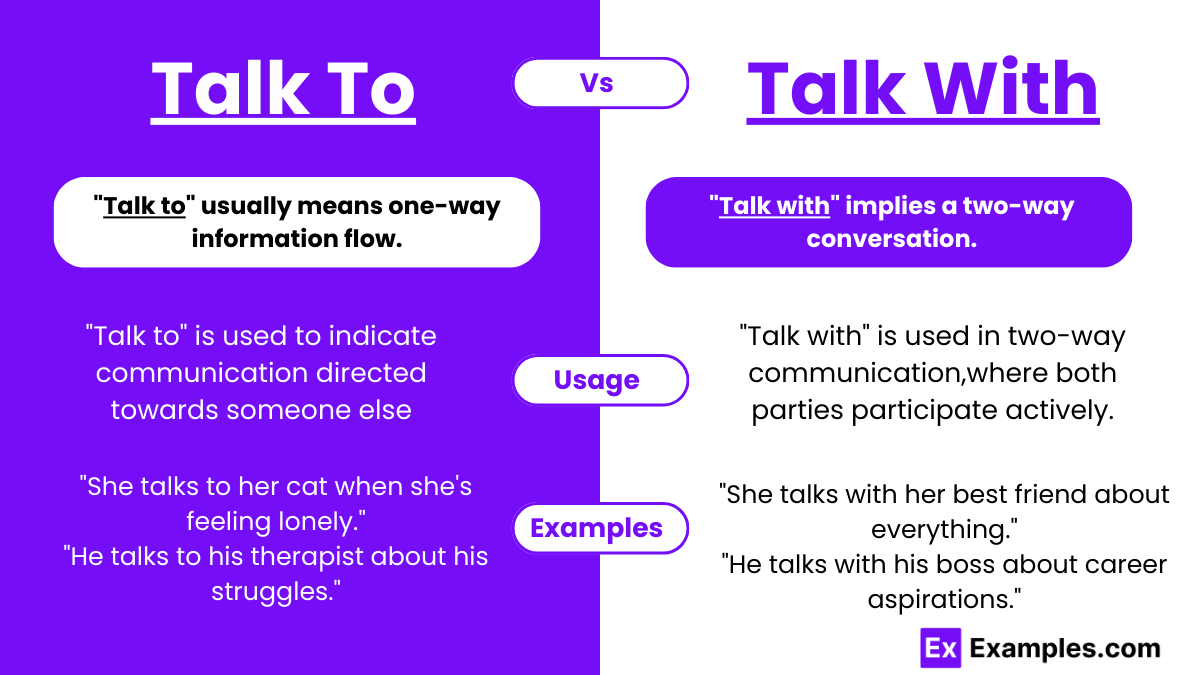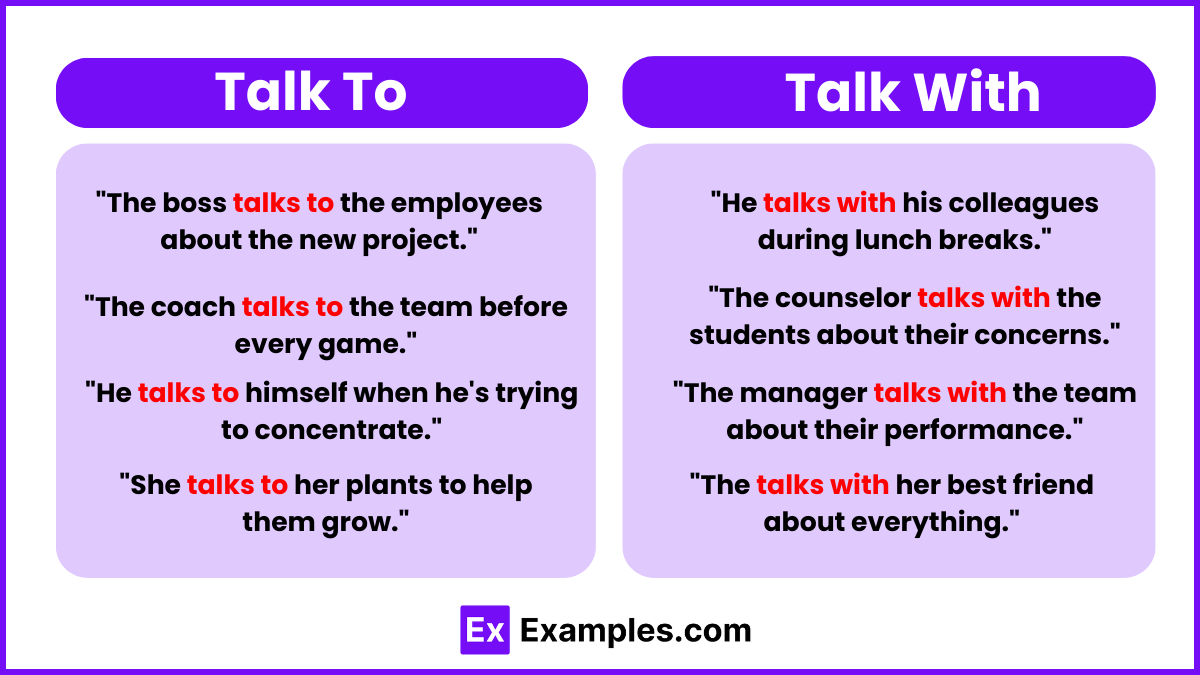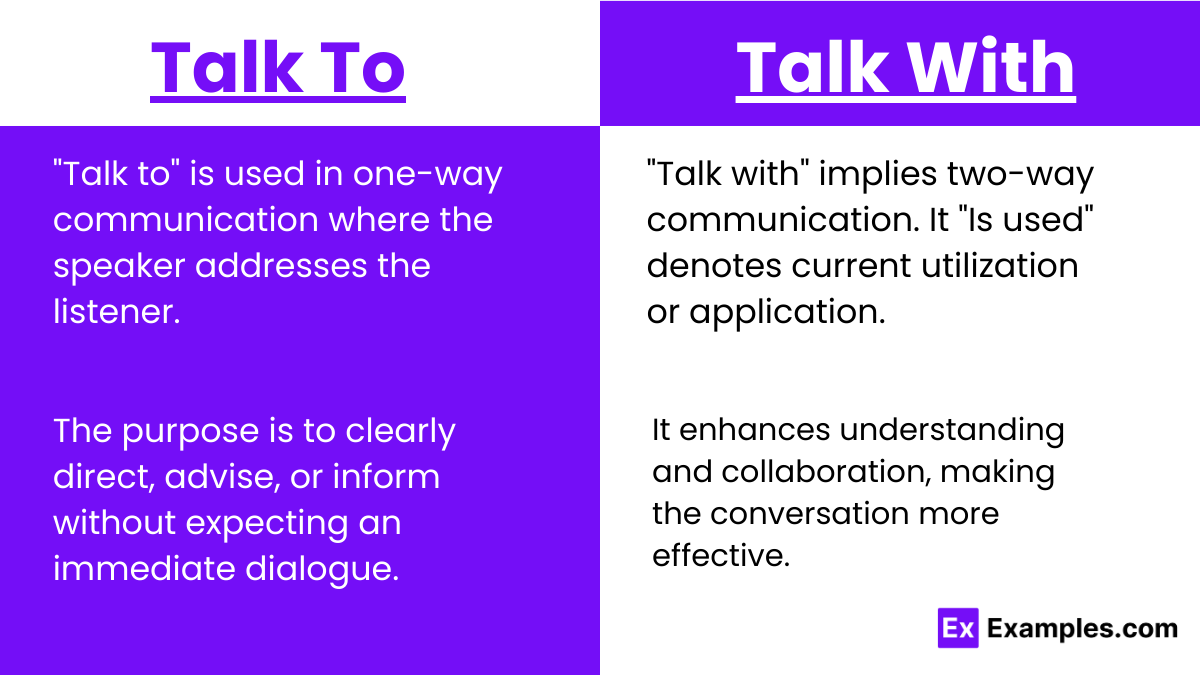Talk To vs Talk With
In the complex tapestry of human interaction, the phrases “Talk to” and “Talk with” emerge as subtle threads, weaving the fabric of our conversations with nuanced distinctions. These terms, often wielded interchangeably by many, carry with them the weight of distinct conversational dynamics. As students navigating the vast seas of communication, understanding the delicate variance between talking “to” someone and engaging “with” them can profoundly shape the contours of our interactions. This article aims to unravel the intricacies of these phrases, casting light on their unique applications and guiding students toward mastering the art of effective dialogue.
Every conversation lies the intent and the relationship between the participants, subtly influenced by the choice between “to” and “with.” Is a dialogue merely an exchange of words, or is it an opportunity for mutual understanding and connection? Through the exploration of “Talk to” versus “Talk with,” we embark on a journey to discern not just the grammatical subtleties that distinguish these expressions but also their implications in fostering more meaningful communication. Whether you find yourself in the halls of academia or the informal gatherings of peers, this article provides essential insights into selecting the right phrase to elevate your conversational prowess.
Talk To and Talk With – Meanings
Talk To: The phrase “talk to” often implies a one-directional flow of information, where the speaker is conveying a message to the listener. It can suggest that the conversation might be more about informing, instructing, or sometimes reprimanding, rather than engaging in a mutual exchange. “Talk to” is commonly used in scenarios where there is a clear sender and receiver of the message, with the emphasis placed on the act of delivering information.
Talk With: Conversely, “talk with” suggests a more reciprocal or bilateral communication process. It indicates that both parties are actively engaged in the conversation, sharing information, ideas, or feelings. The use of “with” implies collaboration and exchange, making it suitable for discussions where input, feedback, and interactive dialogue are encouraged. “Talk with” is often preferred in contexts where equality, partnership, or mutual respect is emphasized in the interaction.
Summary
The phrases ‘talk to’ and ‘talk with’ reflect different dynamics in communication. ‘Talk to’ typically describes scenarios where information is relayed from one party to another, focusing on the act of delivering a message. On the other hand, ‘talk with’ captures the essence of a mutual exchange, where conversation flows back and forth between participants, highlighting an environment of shared dialogue. Remembering the distinction can be simplified by linking ‘talk to’ with instances of telling or informing, whereas ‘talk with’ aligns with engaging in an interactive discussion.
Difference Between Talk To and Talk With
In the nuanced world of communication, the choice between “talk to” and “talk with” can subtly alter the perception of a conversation’s dynamics. These phrases, while seemingly interchangeable, carry distinct connotations that influence the interaction between speakers. Understanding the differences can enhance clarity, foster better relationships, and ensure effective communication. This exploration aims to dissect these variations through a detailed comparison, offering a clearer understanding of when and why to use each phrase appropriately.
Below is a comprehensive table that outlines ten key points of difference between “talk to” and “talk with,” shedding light on their distinct uses and implications in various conversational contexts:
| Aspect | Talk To | Talk With |
|---|---|---|
| Direction | Unidirectional, from the speaker to the listener. | Bidirectional, with active participation from both sides. |
| Implication | Often implies a degree of authority or instruction. | Suggests equality and mutual exchange of ideas. |
| Engagement Level | Lower, as it may not require active participation from the listener. | Higher, as it involves active engagement and dialogue from all parties. |
| Nature of Communication | More formal or instructional, suitable for giving orders or explanations. | More informal and collaborative, ideal for discussions and brainstorming. |
| Emphasis | On the message or information being conveyed. | On the interaction and exchange of ideas. |
| Feedback | Not necessarily expected or immediate. | Encouraged and integral to the conversation. |
| Context | More common in settings where information needs to be imparted clearly, like teaching. | Favored in scenarios requiring input from multiple perspectives, like meetings. |
| Listening | May not require active listening from the receiver. | Requires active listening and consideration of the other person’s viewpoints. |
| Conversational Flow | Can be more linear, with a clear sender and receiver of information. | Characterized by a more dynamic exchange, with roles of sender and receiver constantly shifting. |
| Relationship Dynamics | Can imply a hierarchical relationship, with one person leading the conversation. | Suggests a more egalitarian relationship, with equal contribution from all participants. |
Examples of Talk To and Talk With
Examples of “Talk To”
- “I need to talk to my supervisor about the project deadline.”
- “She decided to talk to her friend about the misunderstanding.”
- “He has to talk to the team about the new strategy.”
- “Can you talk to the kids about their homework?”
- “It’s important to talk to your doctor about any health concerns.”
Examples of “Talk With”
- “Let’s talk with the committee about possible solutions.”
- “He’s planning to talk with his advisor about his career options.”
- “We should talk with our neighbors about organizing a community event.”
- “Let’s talk with the clients to get their feedback on the proposal.”
- “They agreed to talk with the customer about the feedback.”
When to Use Talk To and Talk With
Deciding whether to use “talk to” or “talk with” hinges on the nature of the interaction you intend to have. Here’s a guide to understand when each phrase is most aptly applied:
Usage of “Talk To”
- Instruction or Information is Given: If the conversation is more about imparting information, instructions, or when one person holds more authority in the dialogue, “talk to” is appropriate. It suggests a scenario where the speaker is delivering a message, and the listener is the primary recipient.
- Formal or Less Interactive Contexts: In situations where the conversation doesn’t necessarily require or expect much feedback from the listener, such as in a lecture or a formal announcement, “talk to” fits well.
- Need for Clear Direction: When the purpose is to clearly direct, advise, or inform without expecting an immediate dialogue, “talk to” serves the communication goal.
Usage of “Talk With”
- Mutual Exchange is Expected: If the conversation is intended to be a two-way interaction, where both parties share ideas and engage in a dialogue, “talk with” is more suitable. It implies a more democratic and participatory communication style.
- Collaborative or Informal Settings: In scenarios that benefit from collaboration, brainstorming, or when the setting is more informal and friendly, “talk with” enhances the sense of equality and shared conversation.
- Seeking Feedback or Discussion: When the aim is to explore ideas, solve problems together, or discuss matters requiring input from all involved parties, “talk with” encourages a more engaging and interactive exchange.
Tips for Talk To and Talk With
Navigating the nuances between “talk to” and “talk with” can significantly influence the tone and outcome of your conversations. Here are some universal tips to master the use of both phrases in communication:
- Assess the Interaction Dynamic: Consider the level of authority, formality, and engagement desired. Use “talk to” for more directive or informational exchanges, and “talk with” for interactive, collaborative dialogues.
- Understand the Context: The setting plays a crucial role. Formal or instructional settings lean towards “talk to,” while casual or team-oriented environments favor “talk with.”
- Consider the Relationship: The nature of your relationship with the other person can guide your choice. Hierarchical relationships might necessitate “talk to,” whereas peer relationships often call for “talk with.”
- Clarify Your Intent: Reflect on what you aim to achieve from the conversation. If it’s to deliver a message without expecting much feedback, “talk to” might be appropriate. For mutual exchange and brainstorming, “talk with” is preferable.
- Invite Participation: If you’re looking to encourage dialogue and make the conversation more democratic, leaning towards “talk with” can signal to the other party that their input is valued.
- Adapt Flexibly: Be prepared to switch between the two based on how the conversation unfolds. A session that starts with “talk to” can evolve into a “talk with” as engagement increases.
- Listen Actively: Regardless of which phrase you start with, active listening is key. It enhances understanding and collaboration, making the conversation more effective.
Exercise Problems for Talk To and Talk With
- After class, the professor asked to ________ the student.
- Can we ________ your parents tonight?
- The team leader decided to ________ her team.
- It’s important to ________ a financial advisor.
- She wanted to ________ her colleague.
- The coach needs to ________ the players.
- I think you should ________ the contractor.
- He’s looking forward to ________ his mentor.
- We need to ________ the guests.
- It would be beneficial to ________ a counselor.
FAQs
Which is Grammatically Correct: Talk To or Talk With?
Both “talk to” and “talk with” are grammatically correct. The choice depends on the context of the conversation. “Talk to” is used for more one-sided communications, while “talk with” implies a two-way, reciprocal dialogue. Select based on the interaction’s nature.
How Do You Remember Here and Hear?
To differentiate “here” and “hear,” associate “here” with location, similar to “where,” and “hear” with listening, involving the “ear.” This mnemonic links each word with its function—place for “here” and sound perception for “hear.”
Can I Talk To You or Talk With You?
Both phrases are correct, but their usage depends on the conversation’s intent. “Can I talk to you?” is typically used for conveying information or a discussion where one person leads. “Can I talk with you?” suggests a desire for an equal exchange of ideas.
Is it He Wants to Talk To You or With You?
The choice between “he wants to talk to you” and “he wants to talk with you” hinges on the context. The former suggests he has something specific to communicate, possibly a one-sided message. The latter implies a more open, two-way conversation, indicating mutual engagement.





